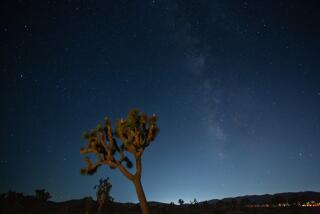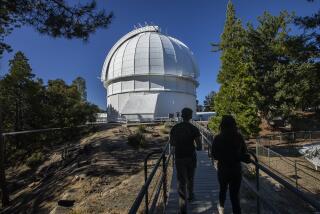CCDs Give It Big Boost : Telescope on Mt. Laguna Takes a Much Longer Look
- Share via
A tiny slab of silicon is pulling the Mt. Laguna Observatory east of San Diego from the backwaters of astronomy into the second wave of a revolutionary way to unlock the heavens’ secrets.
Called a charge-coupled device, or CCD, the electronic wonder is a sophisticated version of the imaging chip inside those low-light video cameras Americans use to preserve Junior for posterity.
But, for San Diego State University astronomers, working with the CCD has been like getting Palomar Mountain’s 200-inch telescope magically transported 45 miles southward to the Laguna Mountains.
Since being installed Aug. 15, the CCD already has enabled astronomers to do work at Mt. Laguna that was “unheard of” before the device arrived, said Ron Angione, SDSU’s astronomy chairman and director of the observatory.
“It allows us to reach objects with our one-meter telescope that in the past it would have taken a 200-inch telescope to see,” Angione said. “We can go 100 times fainter than we did before.”
About 35 miles east of San Diego, near Pine Valley, the Mt. Laguna Observatory has had a respectable but relatively obscure two decades as a research tool for astronomers from SDSU and the University of Illinois at Urbana-Champaign. The two institutions operate it jointly.
Not World-Class Instruments
Laguna’s telescopes, with mirrors 39, 24 and 16 inches across, are professional quality, but they aren’t big enough to be world-class telescopes making discoveries in deepest space.
But the 75 CCDs being distributed to Mt. Laguna and other observatories under a joint NASA/National Science Foundation program will greatly expand the “seeing” ability of U. S. astronomers at smaller observatories, said Jim Westphal, an astronomy professor at California Institute of Technology.
They will be able to do work that, a decade ago, could only be done by the biggest instruments, he said.
“We’re increasing almost by a factor of two the number of groups and people who can do this kind of work,” Westphal said. “It’s a mighty cheap way to get the advantages of a big telescope.”
Although a CCD and its associated computer hardware altogether can cost about $350,000, a major new telescope like the Keck observatory being built in Hawaii runs more than $80 million.
Recognizing that cost picture, NASA and the science foundation are giving the 75 CCDs left over from NASA’s yet-to-be-launched Hubble Space Telescope to 27 groups across the country. About half the recipients are larger observatories, but the rest are smaller ones like Mt. Laguna’s, which will be improved dramatically by the detector, Westphal said.
On a recent night at Mt. Laguna, Angione and University of Illinois Prof. Kenneth Yoss were using the CCD as the imaging device inside a spectrograph--which had been dusted off after 20 years of infrequent use.
“The telescope is small enough that we really couldn’t do anything but real bright stars, so the spectrograph has kind of languished,” Yoss said.
Night of Testing
A spectrograph splits up light collected by the telescope into a rainbow-like spectrum to measure the wavelengths of light emitted and absorbed by a star. The absorption pattern reveals what the star is made of, how hot it is and how it is moving.
After years of having to go elsewhere to do spectroscopy, Angione and Yoss clearly were enjoying their night of testing.
They sat in a cramped control room alongside the big dome of their 1-meter telescope, punching at medium-range stars that nevertheless are invisible to the human eye. Before the CCD, those stars also would have been invisible to the spectrograph without taking hours for each exposure.
On this night, the telescope virtually flitted from star to star, as the scientists explored unfamiliar techniques.
“Every so often we goof up and have to start over again,” Yoss said with a laugh. “If you’re looking at a faint star, you don’t know if you’re going to be over- or under-exposed. Sometimes you sit and groan, other times you cheer.”
As they worked, the newly implanted heart of their imaging system sat encased in a high-tech Thermos bottle filled with liquid nitrogen to keep the CCD at its best working temperature, minus 126.7 degrees Celsius.
This Texas Instruments CCD is a square of iridescent silicon, slightly smaller than a quarter and with a thickness about a tenth the diameter of a human hair. Etched on its surface are microscopic, square indentations--”pixels”--that record light better than any photographic system ever can, scientists say.
The pixels form an 800-by-800 array of rows of electronic buckets, for catching light that is gathered by the telescope mirror and then funneled to the CCD.
When a photon of light hits the silicon, it frees an electron from it. The electrons are captured in the nearest pixel, then the pixel contents are moved one row at a time to the edge of the CCD for counting electronically.
A Digital Picture
Because each “bucket” of electrons is counted individually and systematically, a computer can reconstruct a digital picture of the patterns of light that fell on the CCD. This can be viewed either on a computer screen or converted to a photo.
This arrangement allows astronomers not only to detect minute numbers of photons hitting the telescope--seeing farther out into the universe--but also to detect very fine differences in the amount of light falling on neighboring pixels. This quality is known as dynamic range.
In a photo, the traditional method for doing optical astronomy, a bright star next to a very faint star will wash out the image of the fainter star, because photos can show only 64 gradations between black and white.
But the Texas Instruments CCD can sort out 5,000 light intensities. So, with the help of a computer to screen out the electrons generated by the brighter star, the very faint star’s signal can still be sorted out.
Both CCDs’ light sensitivity as well as their dynamic range have proved important over the past few years at big telescopes. For instance, at a 158-inch telescope in Chile, scientists have used CCDs to look literally at the edges of the universe, the part that formed 1 billion to 2 billion years after the Big Bang.
Gathering light that took perhaps 14 billion years to reach Earth, they have found more than 25,000 galaxies being formed in areas of the sky that previously looked vacant, said Tony Tyson, an astrophysicist at AT&T; Bell Laboratories who worked on the project. That work simply never could have been done with photographic plates, he said.
Until recently, however, the few astronomical-quality CCDs being made were in use only in large, well-funded telescopes.
Whole New Worlds
“The entire rest of the astronomical community has been hunting for good scientific-quality CCDs, and have not been able to find any,” Tyson said. “And that’s why this National Science Foundation distribution of space telescope spinoff CCDs will have made a fairly big improvement in the situation.”
At Mt. Laguna, the CCD means whole new worlds of astronomy for the nine faculty members at SDSU and Illinois, who split 90% of the available observing time. The remaining 10% is allocated to visiting researchers, who already are making inquiries about using the newly improved telescope system, Angione said.
Demand is likely to increase further next year when Kitt Peak National Observatory near Tucson closes down a 36-inch telescope dedicated to the kind of work that Mt. Laguna will be able to do best, Angione said.
Angione explained that galaxies are often too wide for an image of one to fit on a CCD if a large telescope is used.
“The reason is that, as you go to larger telescopes, the amount of the sky that you see shrinks down. At the larger telescopes they cannot get the galaxies, many of them, onto the CCD chip,” he said. “So the one-meter size telescope is just about ideal for an awful lot of galaxies.”
“We’ll be able to get more pictures of galaxies than anyone else in the country,” Yoss said.
Astronomers are looking toward a time, perhaps within the next year, when a new generation of charge-coupled devices will make the Texas Instruments version into the Model T of CCDs. If that happens, Mt. Laguna will already have the hardware--$250,000 in computers donated by AT&T--to; use a new chip, which at less than $40,000 is the least expensive part of a CCD system.






